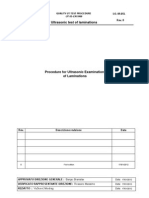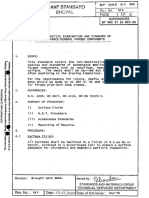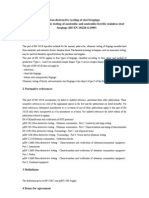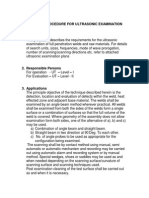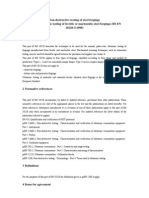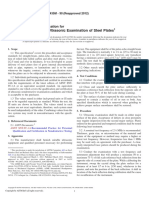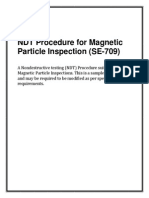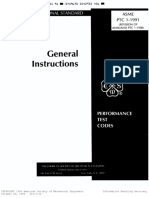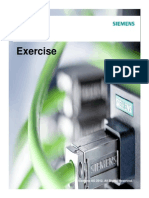0 ratings0% found this document useful (0 votes)
35 viewsNon-Destructive Examination & Standard CF Acceptance For - Forgsd - Pipe Work Stub Pieces
Non-Destructive Examination & Standard CF Acceptance For - Forgsd - Pipe Work Stub Pieces
Uploaded by
veeramalaiThis document outlines non-destructive testing procedures for forged pipe pieces, including visual inspection, magnetic particle inspection, and ultrasonic inspection. It specifies acceptable surface finishes and defect standards. Magnetic particle and ultrasonic testing must comply with British standards and be able to detect defects in any direction. Acceptance standards allow isolated defects up to 3mm but reject pieces with abnormal attenuation or that could interfere with later weld inspections.
Copyright:
© All Rights Reserved
Available Formats
Download as PDF, TXT or read online from Scribd
Non-Destructive Examination & Standard CF Acceptance For - Forgsd - Pipe Work Stub Pieces
Non-Destructive Examination & Standard CF Acceptance For - Forgsd - Pipe Work Stub Pieces
Uploaded by
veeramalai0 ratings0% found this document useful (0 votes)
35 views2 pagesThis document outlines non-destructive testing procedures for forged pipe pieces, including visual inspection, magnetic particle inspection, and ultrasonic inspection. It specifies acceptable surface finishes and defect standards. Magnetic particle and ultrasonic testing must comply with British standards and be able to detect defects in any direction. Acceptance standards allow isolated defects up to 3mm but reject pieces with abnormal attenuation or that could interfere with later weld inspections.
Original Title
BP0850187
Copyright
© © All Rights Reserved
Available Formats
PDF, TXT or read online from Scribd
Share this document
Did you find this document useful?
Is this content inappropriate?
This document outlines non-destructive testing procedures for forged pipe pieces, including visual inspection, magnetic particle inspection, and ultrasonic inspection. It specifies acceptable surface finishes and defect standards. Magnetic particle and ultrasonic testing must comply with British standards and be able to detect defects in any direction. Acceptance standards allow isolated defects up to 3mm but reject pieces with abnormal attenuation or that could interfere with later weld inspections.
Copyright:
© All Rights Reserved
Available Formats
Download as PDF, TXT or read online from Scribd
Download as pdf or txt
0 ratings0% found this document useful (0 votes)
35 views2 pagesNon-Destructive Examination & Standard CF Acceptance For - Forgsd - Pipe Work Stub Pieces
Non-Destructive Examination & Standard CF Acceptance For - Forgsd - Pipe Work Stub Pieces
Uploaded by
veeramalaiThis document outlines non-destructive testing procedures for forged pipe pieces, including visual inspection, magnetic particle inspection, and ultrasonic inspection. It specifies acceptable surface finishes and defect standards. Magnetic particle and ultrasonic testing must comply with British standards and be able to detect defects in any direction. Acceptance standards allow isolated defects up to 3mm but reject pieces with abnormal attenuation or that could interfere with later weld inspections.
Copyright:
© All Rights Reserved
Available Formats
Download as PDF, TXT or read online from Scribd
Download as pdf or txt
You are on page 1of 2
NON-DESTRUCTIVE EXAMINATION & STANDARD CF ACCEPTANCE
FOR_FORGSD_PIPE WORK STUB PIECES
1. GENERAL:
This specification details the procedure for non-destructiv<
examination applicable to forged stub pieces to be welded
into pipe work, steam chest assemblies etc. The tests
shall be carried out by the supplier after machining to
the drawing dimensions*
2* SURFACE FINISH:
All surfaces shall be machined to a finish of 6.25 microns
CLA or better, produced by a broad-nosed tool to permit
ultrasonic and magnetic particle inspection*
3. NON-DESTRUCTIVE TESTING PROCEDURE:
3.1 Visual Examination:
All surfaces shall be visually examined in a clean
condition and any defects observed shall be reported.
3.2 Magnetic Particle Inspection
All surfaces shall be examined. Testing equipment,
conditions and procedures shall be in accordance with
BS_ 4124,. part 2* Techniques shall be such as to detect
defects in any direction. Testing Materials Group 1 of
B.S.4124 are not accepted (i.e.dry powder). Water based
inks are not accepted. Application of magnetic particles
shall be by the continuous method described in BS 4124.
A portable flux indicator shall be used to demonstrate
attainment of an adequate field strength. The attention
of operators shall be drawn to the precautions described
in BS. 4124 part 2 to minimise arcing and excessive
heating of the forging surface at the point of prod contact,
3*3 Ultrasonic Inspection
Testing equipment shall comply with BS.4124 part 1. The
forging shall be scanned on all external surfaces using
a., frequency of 4.5 raHz. End to end tests shall be carried
out, with single crystal longitudinal wave probes.
3.2 Ulcrasonic Inspection : (Contd.../
Racie1 tests shall be carried cut xith combined double
longitudinal wave probes. In the case of flanged forgings
the combined double probes shall be applied to the face
of the flange instead of the circumference. A test block
shall be available in ultrasonically similar steel containing
3 mm flat bottomed holes at varying depths for setting of
sensitivity and evaluation of indications.• The scanning
sensitivity shall be established by obtaining a half screen
echo from a 3 mm FBH at the maximum testing distance and
increasing the sensitivity by 12 dbs. All indications half
screen height shall be recorded. Groups of indications
quarter screen height shall be recorded.
4. ACCEPTANCE STANDARDS:
4.1 Visual and Magnetic Particle Inspection
Cracks are unacceptable. Other defects upto 6 mm in length
and separated by 3 x L, where L is the length of the largest
defect, are acceptable provided there are not more than
three such defects in any area 150 mm x 150 mm. Any
indications outside these levels may be cause for rejection
but may be referred to Technical Services Division, BHEL
Bhopal for concession.
4
"2 Ultrasonic Inspection
Isolated defects up to 3 mm flat bottom hole with no probe
movement are acceptable. Groups of defects giving maximum
• indication greater than half screen height at the testing
sensitivity, and individual defects with probe movement in
excess of that established as appropriate for a 3 mm flat
bottom hole at the relevant depth may be cause for rejection
but may be reffered to Technical Services Division BHSL
Bhopal for concession. Any condition which will cause
interference with the later high sensitivity ultrasonic
examination of the fabrication weld/welds (e.g.abnormally
high "grass" level or attenuation due to coarse grain or
inclusion clouds) will be cause for rejection.
You might also like
- Ut Written InstructionDocument6 pagesUt Written Instructionmm100% (2)
- Magnetic Particle Inspection ProcedureDocument9 pagesMagnetic Particle Inspection Procedurentah84100% (2)
- Astm A 435Document3 pagesAstm A 435Bhavani Prasad100% (3)
- ASTM A435 Examen Ultrasonido PlanchasDocument3 pagesASTM A435 Examen Ultrasonido PlanchasAnonymous wKvJXBJ2iNo ratings yet
- DP Acco. To DS1 PDFDocument58 pagesDP Acco. To DS1 PDFMajdi JerbiNo ratings yet
- Inspection Procedures On Ds 1Document2 pagesInspection Procedures On Ds 1Chaerul Anwar100% (1)
- OI For UT of Laminations-BasicDocument8 pagesOI For UT of Laminations-Basicperogami100% (1)
- Report On Self Supported Roofing System 08.4.15Document40 pagesReport On Self Supported Roofing System 08.4.15Gaddam Padmaja Reddy100% (1)
- Non-Destructive Examination and Standard of Acceptance-General Forged ComponentsDocument5 pagesNon-Destructive Examination and Standard of Acceptance-General Forged ComponentsveeramalaiNo ratings yet
- Not and Acceptance Standards For The Hemispherical Heads of H P. HeatersDocument8 pagesNot and Acceptance Standards For The Hemispherical Heads of H P. HeatersveeramalaiNo ratings yet
- Ultrasonic Inspection of Welds: Section 3.02 ("Non-Destructive Testing Requirements")Document5 pagesUltrasonic Inspection of Welds: Section 3.02 ("Non-Destructive Testing Requirements")carlosNo ratings yet
- Sop MTDocument6 pagesSop MTEddy Dwi CahyonoNo ratings yet
- This Article Provides You With A Sample Magnetic Particle InspectionDocument10 pagesThis Article Provides You With A Sample Magnetic Particle InspectionNiking ThomsanNo ratings yet
- Ut Procedure AsiplDocument29 pagesUt Procedure Asipltushartech009No ratings yet
- Procedure A578Document3 pagesProcedure A578debduttamallik50% (2)
- A435A435M-90 (2012) Standard Specification For Straight-Beam Ultrasonic Examination of Steel PlatesDocument2 pagesA435A435M-90 (2012) Standard Specification For Straight-Beam Ultrasonic Examination of Steel PlatesismaelarchilacastilloNo ratings yet
- IACS-69-NDT StandardDocument15 pagesIACS-69-NDT StandardJeganeswaranNo ratings yet
- Standard Specification For Straight-Beam Ultrasonic Examination of Steel PlatesDocument2 pagesStandard Specification For Straight-Beam Ultrasonic Examination of Steel PlatesHarshkulNo ratings yet
- Section IiiDocument36 pagesSection IiiMuhammad AwaisNo ratings yet
- Ultrasonic Testing of Austenitic and Austenitic Ferritic Stainless Steel ForgingsDocument17 pagesUltrasonic Testing of Austenitic and Austenitic Ferritic Stainless Steel ForgingsAlvice Max100% (2)
- ASTM SA435 SA435M-17(2023)Document3 pagesASTM SA435 SA435M-17(2023)15000182852No ratings yet
- BS en 10228-3Document17 pagesBS en 10228-3Kevin ThomassinNo ratings yet
- Non Destructive Test (NDT)Document8 pagesNon Destructive Test (NDT)Jhean Bernadeth ChavezNo ratings yet
- Ut - Gen Proce-API RP 2xDocument6 pagesUt - Gen Proce-API RP 2xmadhunikhil100% (1)
- Iacs 69 - NDTDocument15 pagesIacs 69 - NDTRicky WCKNo ratings yet
- Magnetic Particle InspectionDocument9 pagesMagnetic Particle Inspectionmuthub4uNo ratings yet
- Straight-Beam Ultrasonic Examination of Steel Plates': Standard SpecificationDocument2 pagesStraight-Beam Ultrasonic Examination of Steel Plates': Standard SpecificationRegis KoroivaNo ratings yet
- MT SpecDocument9 pagesMT Specmunnyrrr100% (3)
- Ultrasonic Testing of Ferritic or Martensitic Steel ForgingsDocument17 pagesUltrasonic Testing of Ferritic or Martensitic Steel ForgingsrkkumarcpriNo ratings yet
- Newut Rev1Document21 pagesNewut Rev1Anonymous AlhzFE9EVNNo ratings yet
- Magnetic Particle Inspection ProcedureDocument9 pagesMagnetic Particle Inspection ProcedureVincent jaramillaNo ratings yet
- UT - ProcedureDocument12 pagesUT - ProcedureVaibhav100% (1)
- Ultrasonic TestDocument11 pagesUltrasonic TestHarry DobleNo ratings yet
- Section13 Spark TestingDocument3 pagesSection13 Spark TestingGustavoNo ratings yet
- TWI-UT-Forgings Procedure For Level 3Document9 pagesTWI-UT-Forgings Procedure For Level 3willypumphandle_5309100% (1)
- Eddy Current Specification Specification: 1. ScopeDocument7 pagesEddy Current Specification Specification: 1. ScopekingstonNo ratings yet
- B Sa-435Document2 pagesB Sa-435Antonio GutierrezNo ratings yet
- A435 PDFDocument2 pagesA435 PDFWanderson WadjôNo ratings yet
- Documents - MX Astm A 435Document3 pagesDocuments - MX Astm A 435Waleed HassanNo ratings yet
- Asme Section II A Sa-435 Sa-435mDocument4 pagesAsme Section II A Sa-435 Sa-435mAnonymous GhPzn1xNo ratings yet
- UT ProcedureDocument14 pagesUT Procedureshifa0% (1)
- Sa 578 UltrasonidoDocument6 pagesSa 578 UltrasonidoDavid EstradaNo ratings yet
- MT 1 PDFDocument6 pagesMT 1 PDFAli MohsinNo ratings yet
- Sa 435Document3 pagesSa 435KHALED OSMAN100% (1)
- Is 4260 2004Document10 pagesIs 4260 2004Mehmet SoysalNo ratings yet
- A 435 - A 435M - 90 (2012) PDFDocument2 pagesA 435 - A 435M - 90 (2012) PDFأسامة وحيد الدين رمضانNo ratings yet
- Ansaldo NDT Specifications 22GRKW v1 0Document117 pagesAnsaldo NDT Specifications 22GRKW v1 0pvssrh9929No ratings yet
- SA275Document8 pagesSA275Venkateswarlu AlaNo ratings yet
- 05 Ultrasonic Test Procedure 500405Document11 pages05 Ultrasonic Test Procedure 500405Sefa KasapogluNo ratings yet
- MT Work InstructionDocument3 pagesMT Work Instructionpandab bkNo ratings yet
- Specification For Ultrasonic Inspection of Al-Alloy Plate For Pressure VesselsDocument6 pagesSpecification For Ultrasonic Inspection of Al-Alloy Plate For Pressure Vesselsmarkieboy36No ratings yet
- Magnetic Particle Test Inspection Free NDT Sample ProcedureDocument8 pagesMagnetic Particle Test Inspection Free NDT Sample ProcedureBhavani Prasad0% (1)
- Ultrasound Analysis for Condition Monitoring: Applications of Ultrasound Detection for Various Industrial EquipmentFrom EverandUltrasound Analysis for Condition Monitoring: Applications of Ultrasound Detection for Various Industrial EquipmentRating: 4.5 out of 5 stars4.5/5 (3)
- New Sensors and Processing ChainFrom EverandNew Sensors and Processing ChainJean-Hugh ThomasNo ratings yet
- Electromagnetic Compatibility: Analysis and Case Studies in TransportationFrom EverandElectromagnetic Compatibility: Analysis and Case Studies in TransportationNo ratings yet
- Exploration and Monitoring of the Continental Shelf Underwater EnvironmentFrom EverandExploration and Monitoring of the Continental Shelf Underwater EnvironmentNo ratings yet
- Penetrant Testing: Principles, Techniques, Applications and Interview Q&AFrom EverandPenetrant Testing: Principles, Techniques, Applications and Interview Q&ANo ratings yet
- Mild Steel Transformer Cooling Tubes: Corporate Purchasing Specification AA 101 05 Rev. No. 02 Preface SheetDocument5 pagesMild Steel Transformer Cooling Tubes: Corporate Purchasing Specification AA 101 05 Rev. No. 02 Preface SheetveeramalaiNo ratings yet
- Amendment - Notification: AA 621 01 00 Rev. No. 01 Page 1 of 1Document4 pagesAmendment - Notification: AA 621 01 00 Rev. No. 01 Page 1 of 1veeramalaiNo ratings yet
- Carbon Steel Pipes-Electric Resistance Welded/Submerged Arc WeldedDocument5 pagesCarbon Steel Pipes-Electric Resistance Welded/Submerged Arc WeldedveeramalaiNo ratings yet
- Corporate Standard: File-Engineer'S, Half Round, Standard, Double CutDocument2 pagesCorporate Standard: File-Engineer'S, Half Round, Standard, Double CutveeramalaiNo ratings yet
- Ultrasonic Testing and Acceptance Standard For Fabricated Armature ShaftDocument4 pagesUltrasonic Testing and Acceptance Standard For Fabricated Armature ShaftveeramalaiNo ratings yet
- Evaluation and Acceptance Standard For Magnetic Particle Examination of WeldsDocument1 pageEvaluation and Acceptance Standard For Magnetic Particle Examination of WeldsveeramalaiNo ratings yet
- Non-Destructive Testing and Acceptance Standards For Steam Turbine CastingsDocument14 pagesNon-Destructive Testing and Acceptance Standards For Steam Turbine CastingsveeramalaiNo ratings yet
- Weld Quality and Inspection Requirbments For Ip Cylinder Fabrications For 236 MW TurbineDocument4 pagesWeld Quality and Inspection Requirbments For Ip Cylinder Fabrications For 236 MW TurbineveeramalaiNo ratings yet
- !5 M - T I 2!N - !i - gpx3gp - : Ultrasonic Testing of IntegralDocument2 pages!5 M - T I 2!N - !i - gpx3gp - : Ultrasonic Testing of IntegralveeramalaiNo ratings yet
- TSP in Excel PDFDocument23 pagesTSP in Excel PDFJuank Z BkNo ratings yet
- Bacterial Leaching: Biotechnology in The Mining IndustryDocument8 pagesBacterial Leaching: Biotechnology in The Mining IndustryWILLNo ratings yet
- PROVA cm-07Document10 pagesPROVA cm-07hidrologia05No ratings yet
- A. Kommy UnitDocument13 pagesA. Kommy UnitMn AnaNo ratings yet
- Basic Schema Types: Drupal 8 Configuration Schema Cheat SheetDocument2 pagesBasic Schema Types: Drupal 8 Configuration Schema Cheat SheetAntonio CardonaNo ratings yet
- Asme PTC 1 PDFDocument26 pagesAsme PTC 1 PDFpiziyuNo ratings yet
- BS en 14718-2014Document22 pagesBS en 14718-2014gokhanekinci92No ratings yet
- Effect of Thermal Aging On Impact Strength ABSDocument5 pagesEffect of Thermal Aging On Impact Strength ABSdsqdNo ratings yet
- Cem III-A 42,5 N-LH (En)Document2 pagesCem III-A 42,5 N-LH (En)danbelaNo ratings yet
- Comparasion - of - SGSN, SGW, PGW, GGSN CDRs - ZEDocument31 pagesComparasion - of - SGSN, SGW, PGW, GGSN CDRs - ZERasool WaniNo ratings yet
- Bauxite To Alumina Book 2018Document33 pagesBauxite To Alumina Book 2018Amogh Vaishnav100% (1)
- #1 (1570388189) - The Wireless Energy Transfer (WET) Using Ultra High Frequency (UHF) For Human Body Implant Recharging (ASTECHNOVA 2017) EDAS (1509064 - Fahmyrs@Yahoo - Com)Document2 pages#1 (1570388189) - The Wireless Energy Transfer (WET) Using Ultra High Frequency (UHF) For Human Body Implant Recharging (ASTECHNOVA 2017) EDAS (1509064 - Fahmyrs@Yahoo - Com)FAHMY RINANDA SAPUTRI (066629)No ratings yet
- CN18550 AMY-25-ZOOM 20220408 MechanicalDrawingDocument1 pageCN18550 AMY-25-ZOOM 20220408 MechanicalDrawingLuar ParraNo ratings yet
- Catalogo ArruelasDocument32 pagesCatalogo ArruelasMarcelo Godinho BatistaNo ratings yet
- Hydraulic JumpDocument11 pagesHydraulic JumpAhmed Al-IraqiNo ratings yet
- H250 Manual PDFDocument80 pagesH250 Manual PDFKaran SolankiNo ratings yet
- Learner's Progress Chart: ACLC College Tagbilaran CityDocument3 pagesLearner's Progress Chart: ACLC College Tagbilaran CityLaput Ronel0% (1)
- Scroope Saleem1Document5 pagesScroope Saleem1atik faysalNo ratings yet
- Handbook of Training in Mine Rescue and Recovery OperationsDocument299 pagesHandbook of Training in Mine Rescue and Recovery OperationsTarcisioNo ratings yet
- Experiment No. 3Document12 pagesExperiment No. 3Lemuel Larin0% (1)
- Brocade Adapters v2.1.0.0 Troubleshooting GuideDocument116 pagesBrocade Adapters v2.1.0.0 Troubleshooting GuideStephen McLeanNo ratings yet
- Astable Monostable 555Document5 pagesAstable Monostable 555SUNOBHAINo ratings yet
- Code Book Chapter No.1Document4 pagesCode Book Chapter No.1Rana IrfanNo ratings yet
- ZGOWDocument18 pagesZGOWjoker hotNo ratings yet
- LKPD Procedure Text 1Document8 pagesLKPD Procedure Text 1Noven ArdiansyahNo ratings yet
- Fiberglas 703 and 705 Series Insulation Product Data SheetDocument2 pagesFiberglas 703 and 705 Series Insulation Product Data Sheetkevin.pmtmc16100% (1)
- Vibrations Phonons3Document53 pagesVibrations Phonons3Kartik Dutta67% (3)
- Exercise TutorialDocument72 pagesExercise TutorialYahyaMoummou100% (7)
- Convert From Decimal To BinaryDocument10 pagesConvert From Decimal To BinaryKEO PHEAKDEYNo ratings yet






